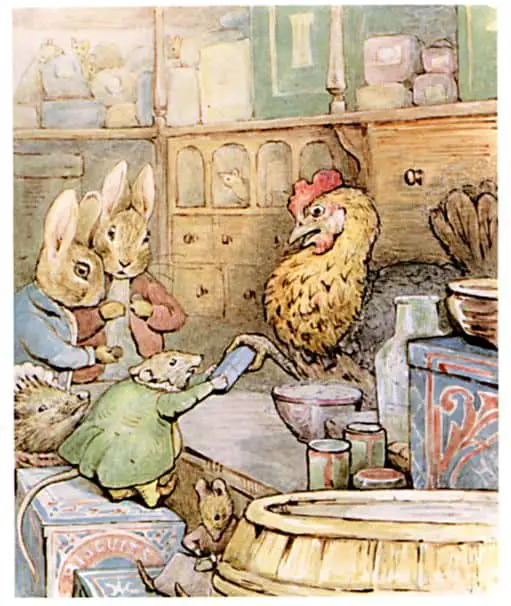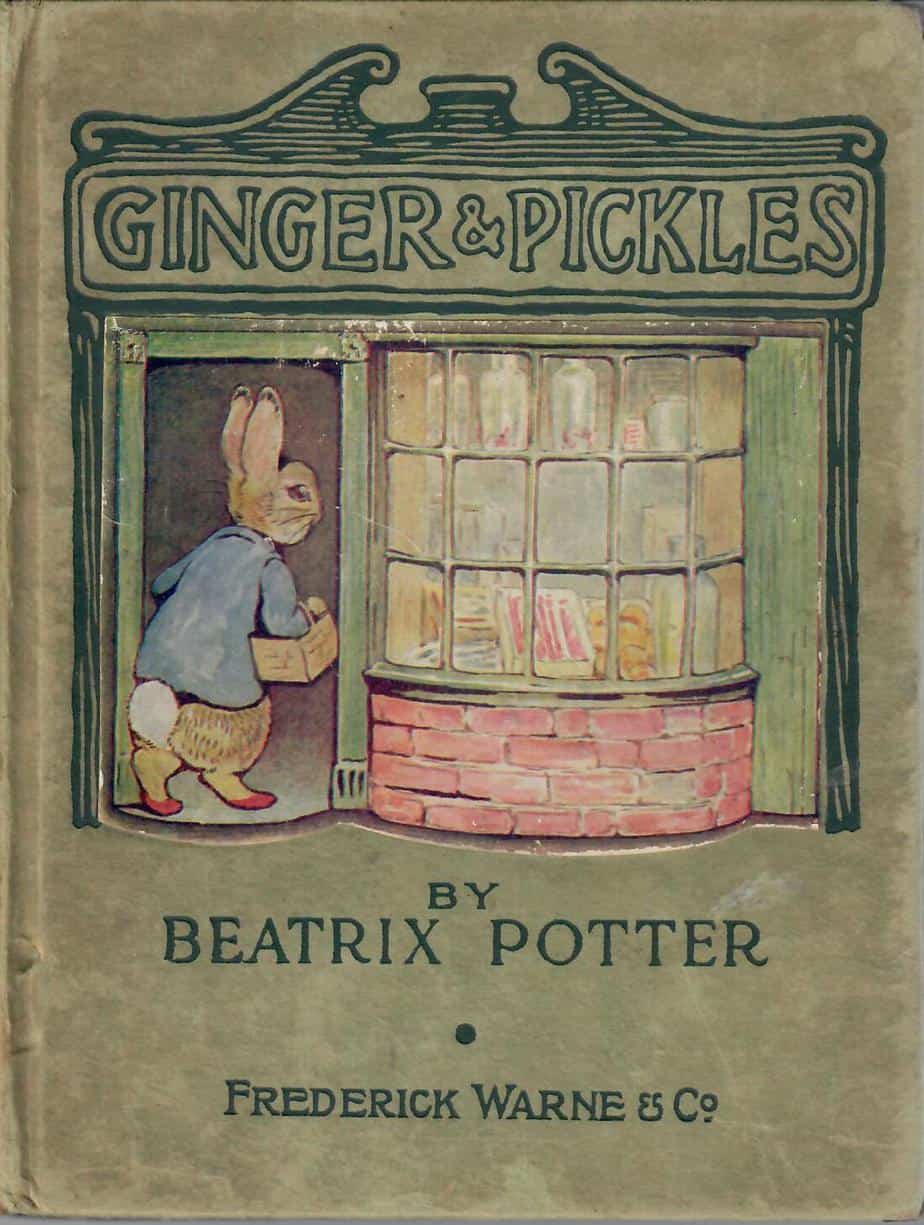The Tale of Ginger and Pickles by Beatrix Potter is a story of utopian, idealised capitalism, first published 1909. This is how we’d all like capitalism to work — small local businesses provide goods and services; those friends providing the best goods and services win out, those ill-suited to small business find other, more suitable occupations. All is fair and just.
We see this micro-capitalist retail structure even in contemporary children’s books published today. We also see it in toys — the Sylvanian Families line of dolls offers for sale a utopian smalltown market, with tiny pastries, pots and pans and a world populated by nuclear families of animals in clothes.
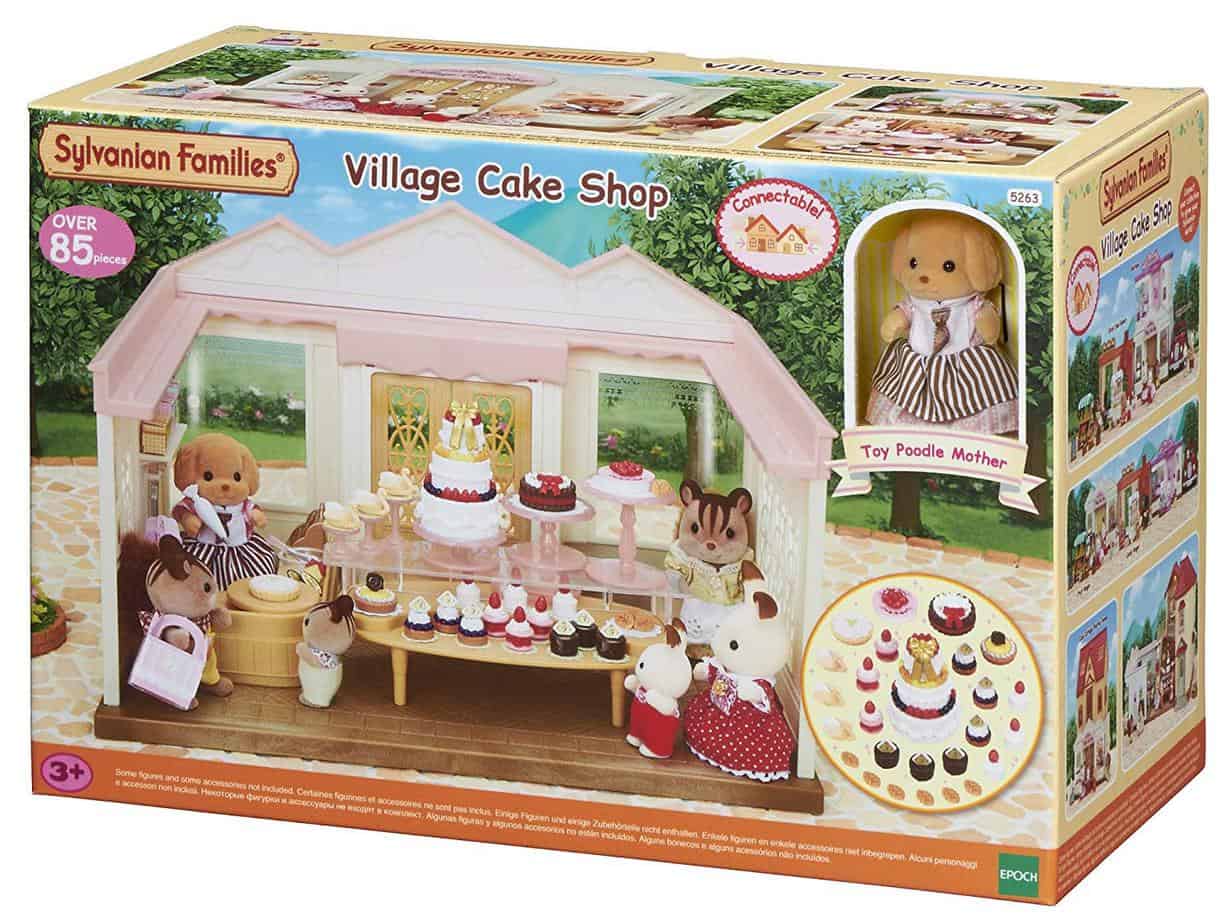
Ginger and Pickles is also a bit like a contemporary vampire story a la Twilight, focusing on the repression of one’s natural desires, and eventual escape into the wild where these can be satiated.
STORYWORLD OF “GINGER AND PICKLES”
The book is illustrated in a mixture of colour and black and white line drawings. The colour illustrations are very detailed while the line drawings aren’t very detailed at all, compared to how Potter sometimes rendered her line work.
My parents’ generation grew up with an old-fashioned supplies store as described in Ginger and Pickles, and I’ve been told that when supermarkets first opened in New Zealand, many customers (mostly women) were reluctant to use them. It felt like theft to walk around and pick your own thing from the shelves. Asking a grocer to take things down for you seemed more polite, somehow, as if the act of ‘giving’ provided a kind of permission to buy. I think of supermarket food as owned by a faceless corporation but, back then, shopping must have felt more like walking into someone’s kitchen and requesting to have some of their own food.
I’m thinking of a sketch by The Two Ronnies from 1976. By this time in England, the old-fashioned shopkeeper was on his way out and the background of the gag below is that “Nothing is too much trouble.” These places remained in existence precisely to keep serving the customers who had grown up with the village grocer as a local friend and personality. This exact culture can be seen in 1970s comedies such as To The Manor Born but we still see it today in the pharmacy scenes of Doc Martin. Butchers and pharmacists still operate like those old-fashioned shops. There are few other examples where the customer needs to interact with the shopkeeper.
Meanwhile, the smaller Ronnie really tests this maxim. All the while, the shopkeeper tries to keep up the facade of jovial companionship, providing not just the service of goods but also the social service of ‘an outing’. He ultimately fails to keep his cool, leading to carnivalesque chaos. And if an old-fashioned grocer can’t manage to keep his cool, he proves himself redundant in the late seventies era of supermarkets.
The characters of Ginger and Pickles, as depicted by Beatrix Potter, are providing the ultimate grocery service — no one pays for anything. She describes the concept of ‘credit’ for young readers in the text, who aren’t meant to ask, well, where are all these products coming from, then? Rather than go into that, Potter mentions the terrier of the pair can’t afford a dog licence. I would’ve thought the dog licence is the least of their financial worries, but this is a payment the young reader can identify with.
DOG LICENCES
I wondered if it were true that terriers needed dog licences in England but collies didn’t. I’m yet to find an answer to this so if you know the answer, flick me an email.
VOCABULARY OF GINGER AND PICKLES
A wigg is a kind of bun or small cake made of fine flour, less sweet than your regular sweet bun. The seeds used in sweet baked goods were probably caraway seeds. Potter has spelt it with a single g, but it was often spelt with two. Perhaps Potter knew this but wanted to retain the imagery of hair, and that’s why she put the word in speech marks.
A self-fitting candle means that it has been designed to fit into a standard sized candle-holder, which came in a variety of sizes. In the early 1900s people would’ve been as familiar with these sizes as we are familiar with bulb types today (though I still often manage to buy the wrong one).
£3 19 11 3/4 is read “three pounds, nineteen shillings and eleven pence three farthings. This is the equivalent of advertising a product at 99p instead of a pound because this is 1 farthing short of four pounds, so it’s mildly humorous that the ‘rates and taxes’ have come to this exact amount, which seems like a grocer’s special.
“Send us all the bills again to everybody ‘with compts‘,” replied Ginger. This appears to be a shortened form of ‘with compliments’.
STORY STRUCTURE OF “THE TALE OF GINGER AND PICKLES”
SHORTCOMING
Ginger & Pickles is a small supplies store specialising in sweets. The shop is named after its cat and dog owners.
In picture books and in idiomatic expressions such as ‘fight like cats and dogs’, cats and dogs are often depicted as living at loggerheads, but I’ve noticed that in reality a well-fed cat and a dog living in a domestic household together are just as likely to get on as two cats or two dogs (who quite often despise each other). In my experience, cats in particular can really hate each other, even if they’re from the same litter. (Bear that in mind if you get yourself two kittens thinking they’ll automatically be best buds.)
Potter doesn’t get into any antagonism that you often see between cats and dogs — Ginger and Pickles get along fine, sort of like a married couple. They know each other well and rib accordingly. But there is another Shortcoming — Potter’s animal characters hover in that awkward space between ‘humans in animal form’ and ‘proper animals’ — although they own a shop and speak English like humans, they are driven by their baser instincts and would quite like to eat the customers. The terrier would like to eat the rabbits and the cat would like to eat the mice. They acknowledge this shortcoming in themselves and have developed strategies; the cat serves the rabbits and the dog serves the mice. (In fact terriers also like mice and were bred as ratters. I doubt terriers make a fine distinction between rodents.)
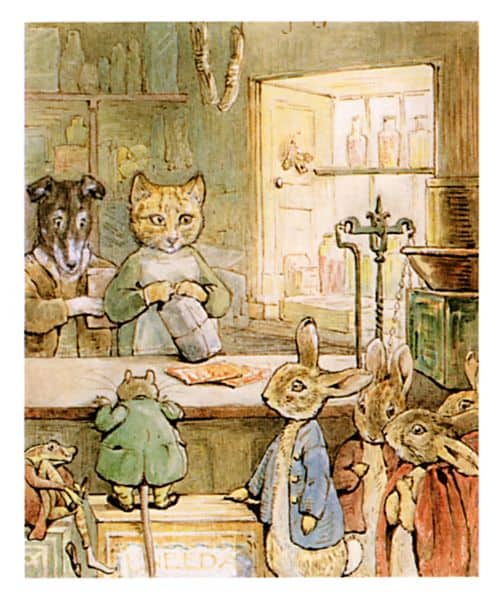
DESIRE
Here’s what I think. I think Ginger and Pickles Desire the parade of edible customers who visit their little store. In fact, they are basically enticing them there with free sweets. They are setting up traps, and they enjoy the hands-off fantasy parading in front of them all day.
Because WHY THE HELL ELSE would they do this entire thing? They’re not making any money.
OPPONENT
The customers themselves are set up as opposition, though what Ginger and Pickles are not receiving in financial reward they are receiving in some other kind of gastro-porn buzz.
The off-the-age Opponent is the other shopkeeper — opposition not just for these shopkeepers but for the patrons as well, as Tabitha Twitchit is a much better business person and doesn’t give credit, knowing exactly how that would end.
PLAN
They try to extend their credit, for example by asking for credit on the dog licence at the post office. They ask their customers to pay for what they owe, but never follow up.
This the extent of their business acumen. They don’t change the rules to ‘no credit’. They don’t visit their customers at their homes and ask to be paid. No threats, no violence. Their baser instincts therefore remain in check.
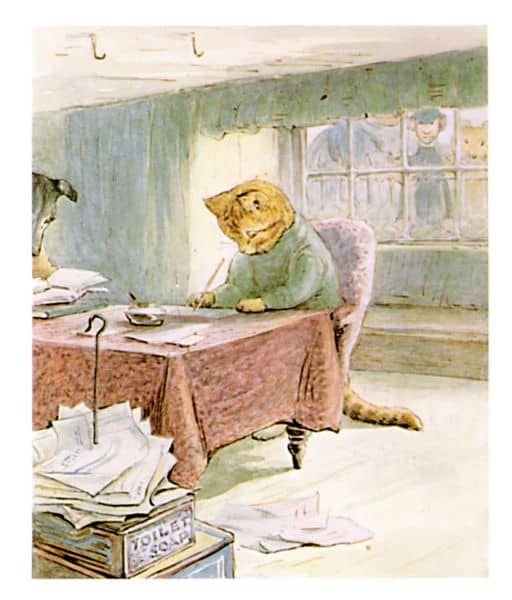
BIG STRUGGLE
The Battle scene involves the German police doll — were Germans more scary in 1909 perhaps? Would an English-made doll have seemed safer? The bead eyes have inherent horror, utilised also in a horror middle grade story like Coraline (where the eyes are buttons). The policeman’s helmet has been sewn onto his head. Ginger points out that this renders him harmless, whereas Potter knows this is exactly the stuff of horror. This tiny, spindly policeman doll is therefore formidable and scary enough to warrant Ginger and Pickles closing up shop and heading back into nature.
ANAGNORISIS
Well, since Ginger and Pickles have been forced out of their business by circumstance, this didn’t lead to any Anagnorisis — only the grim realisation that they were not cut out for independent retail.
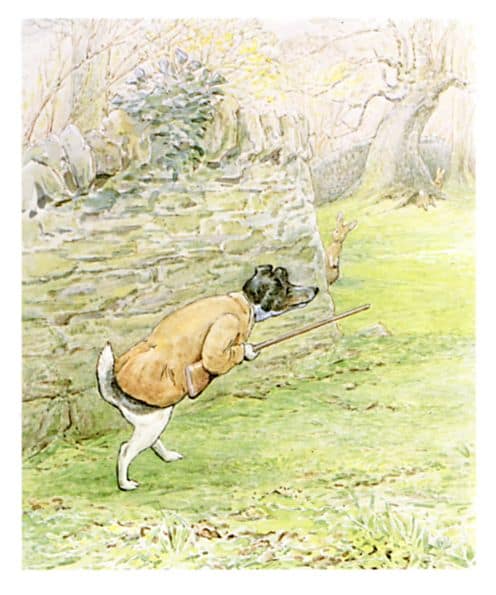
Instead, Potter gives us the Anagnorisis of the rest of the village. The closure sets off a chain of events and the narrator explains to the reader what the customers will have realised: By taking advantage of the free goods at Ginger & Pickles’, the very existence of another grocery store was keeping the price of Tabitha Twitchit’s goods down.
At this point, Potter gives us the mini-plot of the Dormouses (Dormice?), who unsuccessfully sell candles, ‘which behave very strangely’. The images of the drooping candles are spooky even in black and white, standing about as high as the mice themselves and therefore looking like hooded figures come to collect the dead.
This is an unusual place to put a mini-plot, but the preface to this edition tells us that:
The storyline was slightly altered from Beatrix’s original conception, as she wanted to include a character representing her local shopkeeper, John Taylor, who was now bedridden. He suggested he might pass as a dormouse, and so John Dormouse appears in the tale.
I haven’t seen Beatrix’s unedited manuscript but I can guess John featured in the main part of the story, Beatrix was asked to remove him as it complicated the plot unnecessarily, and knowing what we’re told of Beatrix’s personality she would’ve refused to remove him completely, so it was agreed she tack him on at the end as she has done here.
I don’t think this is an ideal story structure. As a result, this is not the most resonant of Potter’s books, but she was already very popular by 1909 and she had a certain amount of sway on her own products. Thusly, we get the story of the candles and John Dormouse in an odd place. I do think the candle story is itself pretty cool, but not at this point in the plot, when the reader is expecting a summary of the main narrative.
NEW SITUATION
This is a happily-ever-after tale — Sally Henny-penny re-opens the abandoned store, calls it something new and obviously knows how to run a business properly because she draws the customers in with specials and only accepts cash (as opposed to credit). Chickens are obviously harmless, to everyone but slugs and worms and insects, that is.
